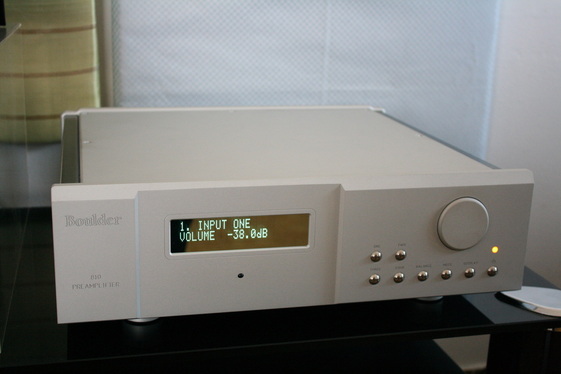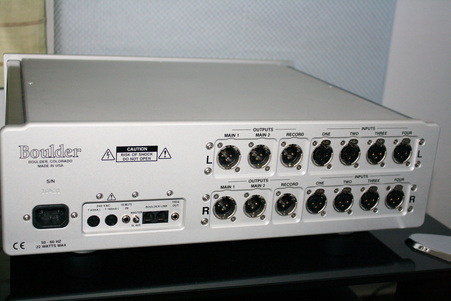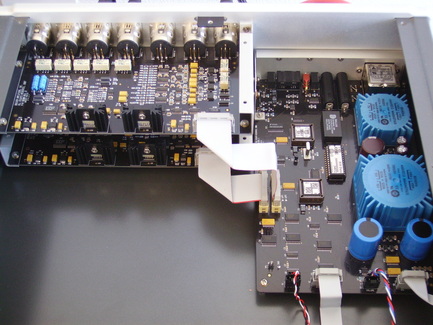Boulder 810

We all know Boulder but a short presentation may be useful
anyway. Boulder is an American enterprise that has its base in Boulder,
Colorado. In its early times it was focused on technical equipment and after
some time they started to produce their first electronics for home use. The
wonderful Series 2000 was the first one then followed the Series 1000, the
Series 800 that belongs to the cheaper range produced by Boulder and, in the
end, the unattainable Series 3000. In the Series 800 we find an integrated amp,
a pre amp, one stereo power amp and two mono amplifiers. The pre amplifier 810
is what we are going to review now. During the years, I have had the chance to
appreciate the sound of the 1012 pre amp with DAC and built in phono
preamplifier, the Series 1000 power amplifier, the sound of the Series 2000 pre
and power amplifiers. Last but not least, I listened to the world acclaimed
2008 phono pre, that can be bought for
"only" 30 000 euros.
This time I want to do something different from the usual routine and I will not speak about the single listening sessions but about the Boulder sound in general. I connect to my system the 810, a device that looks good with a satinated aluminum plate that feels nice when touched. It has a vertical asymmetrical slot; the brand and the model name are carved on the left side. In the same slot, there is a mirror display and, below, the remote sensor. The remote is a heavy piece of aluminum, it has a strange but ergonomic shape and has big metal marbles that are the buttons.These buttons are very pleasant to touch and are so strong that there can be no doubt about the solidity of the object. On the right of the pre amp display there are other eight metal marbles that are switches and are, once again, very pleasant at the touch.There is also the volume knob that can be turned without limitations, being an optical control, without mechanic contacts to limit it. The buttons are designed to control inputs, balance, the absolute polarity and the display's dimmer.
This time I want to do something different from the usual routine and I will not speak about the single listening sessions but about the Boulder sound in general. I connect to my system the 810, a device that looks good with a satinated aluminum plate that feels nice when touched. It has a vertical asymmetrical slot; the brand and the model name are carved on the left side. In the same slot, there is a mirror display and, below, the remote sensor. The remote is a heavy piece of aluminum, it has a strange but ergonomic shape and has big metal marbles that are the buttons.These buttons are very pleasant to touch and are so strong that there can be no doubt about the solidity of the object. On the right of the pre amp display there are other eight metal marbles that are switches and are, once again, very pleasant at the touch.There is also the volume knob that can be turned without limitations, being an optical control, without mechanic contacts to limit it. The buttons are designed to control inputs, balance, the absolute polarity and the display's dimmer.

The four
inputs are only balanced and the two power outputs are balanced, too; then
there is an output for a recorder. Unbalanced devices can be connected through
special cables provided upon request by Boulder or through a special Boulder adaptor. It is not
recommended to use adaptors that are not specific for Boulder, since they may
have bridges that are not fit for this component. The back panel has the usual
IEC A/C input, 2 fuses, an input for an
additional receiver for the remote, a master/slave switch and the Boulder links
that we will describe later on. The chassis, just like the front panel , is
very solid and well refined. Boulder declares that the chassis is manufactured
in house, with CNC machines. The top lid is very strong and when lifted and hit
there seem to be no resonances. I was almost forgetting about the stand-by led
light. When the device is on, the colour is amber and when it is in stand-by,
it changes endlessly color from amber to red to green. I found it very nice, it
seems to say "Hey! I'm here! Turn me on." A quick look to the
manufacturing technique and to the many possibilities of use of the 810 is
useful. As we already said, this is a balanced electronics and is fully
dual-mono. The A/C is filtered by the same IEC input as can be seen from the
picture of the inside. The two A/C transformers are separated, one for the
analog and one for the digital function control. All this to avoid self-induced
noises. The volume control that uses a Boulder proprietary system, adjusts the
volume output with 0,5 dB steps. The Boulder Link controls the whole amplifying
system and reports possible malfunctionings of all the Boulder components
linked to the display of the pre amp. Electronics wonders! Through the display
it is possible to program every input giving it a different name, to set the
desired volume level when the device is switched on and also set the gain, the
balance and the absolute polarity. It is
also possible to assign to each input
the function "Theatre" that allows to bypass the volume
control, when audio/video processors are in use. The display has a green
typeface that is very nice and easily readable from the distance. Its brightness
is adjustable but it's not possible to darken it completely. The master/slave
switch is made to control the Boulder Link that is the system implemented by
cables that are supplied upon request and that connects all the Boulder
amplification or source devices. In this way they are all linked as in a
computer network. It also allows the turning on of all the electronics at
predefined intervals and the sensing of the malfunctioning of the power amps,
including clipping, unexpected high temperature, or the presence of continuous
A/C. The circuits are extremely well engineered, there are many SMD components
and integrated circuits, some of them have been designed by Boulder engineers.
There are two motherboards, well divided for each stereo channel. thanks to the
integrated electronics components there is a lot of free space.

The 810 has been connected to the following system:Turntable Basis 2001, tonearm Graham 2.2, cartridge Scan Tech
Lyra Helikon, phono preamplifier: Einstein "The Turntable's Choice",
CD/SACD player dCS Puccini + Puccini U-Clock, preamplifier: MBL 4006, power
amplifiers: Bryston 7B ST mono, loudspeakers: JBL 4350B, interconnect cables:
MIT Oracle MA-X Proline, MIT Shotgun S2 RCA, Transparent Super XLR, Transparent
Super RCA, LAT International XLR, loudspeaker cables: MIT Magnum MA, Vovox
Initio, power cables: MIT Shotgun AC 1, Black Noise Pearl and others DIY, mains
distributor: Lector Edison 230/8, mains filter: Black Noise 2500.
I have found the sound of the 810 very spectacular and with a surprisingly correct timbric. There are no special preferences in the reproduction of the whole range of frequencies and the medium range has the nuances of high class tube devices.Dynamics is incredible and the soundstage is really good, especially when the preamplifier reaches the right temperature. One hour of heating is the right lapse of time to have a perfect sound, in my opinion. Its performance is at a high level while its price is in the medium-high range. I said that the medium range that has impressed me a lot, in fact a similar reproduction in solid state components is really rare believe me. About the bottom range there is little to say, it is appropriate in every occasion and only a bit “softer” when compared to my reference system. I have been lucky enough to listen to many systems in my life and I wish more systems had this bottom range. As for the top range, it is simply “not present”. And this is positive, believe me. The instruments that arrive to such peaks sound natural and bright, with just a hint of amber. The higher harmonics are present and records have the right ambiance. It is transparent and made me discover, in a CD that I know perfectly like "The Ghost of Tom Joad" by Bruce Springsteen, details that I had never heard before.
Beethoven’s Sixth Symphony directed by Simon Rattle and played by the Wiener Philharmoniker confirms how this system is capable of taking by the hand the whole system … and the listener. It is able to take you straight in front of the orchestra. The dynamic push in the crescendo is really great but natural, without efforts. The illusion of the deepness of the orchestra is perfect just like the height and deepness of the sound stage. This Boulder has a timbric balance that allows a nice reproduction of the sound for the whole audible range, and it does not add personal characteristics to it. What a nice sound! Cellos and double basses sounds aren’t melted and those of you that are concert goers know that this is normal with live music but not easy to achieve at home with a system.
Well, many times when I review components I can't wait to reconnect my reference system but this time it was different. I have let the Boulder play for many days, I had also few friends visiting and the music remained a pleasant base and not once became an annoying or disturbing background. A dynamic sound, full of details but always perfect as if I was listening to live music. Micro and macro dynamics are always at good levels and the instruments are always credible and as fast as they should be.
The result is a sound that is melody and not just keys without a soul, without emotion and we all know how important emotion is when listening to music. If you are looking for an amplification in this price range it would be a pity not to listen to this Boulder. Very little Hi-Fi in the meanest sense of the word but a lot of good music that will stay with you until you … will switch to a bigger Boulder.
For its brand, the options of use, the level of manufacturing and the performances, it is not too expensive in my opinion. It is probably the best preamplifier I know in this price range.
Angelo Jasparro
Translation: Francesca Rubino
Manufactured by: Boulder Amplifiers, Inc.
I have found the sound of the 810 very spectacular and with a surprisingly correct timbric. There are no special preferences in the reproduction of the whole range of frequencies and the medium range has the nuances of high class tube devices.Dynamics is incredible and the soundstage is really good, especially when the preamplifier reaches the right temperature. One hour of heating is the right lapse of time to have a perfect sound, in my opinion. Its performance is at a high level while its price is in the medium-high range. I said that the medium range that has impressed me a lot, in fact a similar reproduction in solid state components is really rare believe me. About the bottom range there is little to say, it is appropriate in every occasion and only a bit “softer” when compared to my reference system. I have been lucky enough to listen to many systems in my life and I wish more systems had this bottom range. As for the top range, it is simply “not present”. And this is positive, believe me. The instruments that arrive to such peaks sound natural and bright, with just a hint of amber. The higher harmonics are present and records have the right ambiance. It is transparent and made me discover, in a CD that I know perfectly like "The Ghost of Tom Joad" by Bruce Springsteen, details that I had never heard before.
Beethoven’s Sixth Symphony directed by Simon Rattle and played by the Wiener Philharmoniker confirms how this system is capable of taking by the hand the whole system … and the listener. It is able to take you straight in front of the orchestra. The dynamic push in the crescendo is really great but natural, without efforts. The illusion of the deepness of the orchestra is perfect just like the height and deepness of the sound stage. This Boulder has a timbric balance that allows a nice reproduction of the sound for the whole audible range, and it does not add personal characteristics to it. What a nice sound! Cellos and double basses sounds aren’t melted and those of you that are concert goers know that this is normal with live music but not easy to achieve at home with a system.
Well, many times when I review components I can't wait to reconnect my reference system but this time it was different. I have let the Boulder play for many days, I had also few friends visiting and the music remained a pleasant base and not once became an annoying or disturbing background. A dynamic sound, full of details but always perfect as if I was listening to live music. Micro and macro dynamics are always at good levels and the instruments are always credible and as fast as they should be.
The result is a sound that is melody and not just keys without a soul, without emotion and we all know how important emotion is when listening to music. If you are looking for an amplification in this price range it would be a pity not to listen to this Boulder. Very little Hi-Fi in the meanest sense of the word but a lot of good music that will stay with you until you … will switch to a bigger Boulder.
For its brand, the options of use, the level of manufacturing and the performances, it is not too expensive in my opinion. It is probably the best preamplifier I know in this price range.
Angelo Jasparro
Translation: Francesca Rubino
Manufactured by: Boulder Amplifiers, Inc.

